Discover 20 hidden attractions, cool sights, and unusual things to do in Egypt. Don't miss out on these must-see attractions: Egyptian Museum (Cairo), Karnak (Luxor) or Medinet Habu (Luxor).
Below, you can find the list of the most amazing places you should visit in Egypt.
Table of Contents
Egyptian Museum, Cairo
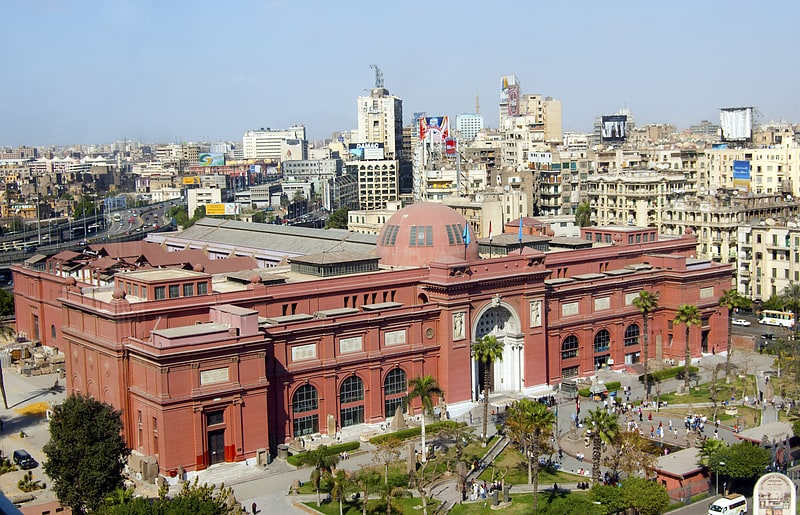
Also known as: المتحف المصري
Museum in Cairo, Egypt. The Museum of Egyptian Antiquities, known commonly as the Egyptian Museum or the Cairo Museum, in Cairo, Egypt, is home to an extensive collection of ancient Egyptian antiquities. It has 120,000 items, with a representative amount on display and the remainder in storerooms. Built in 1901 by the Italian construction company, Garozzo-Zaffarani, to a design by the French architect Marcel Dourgnon, the edifice is one of the largest museums in the region. As of March 2019, the museum was open to the public. In 2022, the museum is due to be superseded by the newer and larger Grand Egyptian Museum at Giza.[1]
Address: Midan El Tahrir, 11511 Cairo (وسط البلد)
Karnak, Luxor

Also known as: معبد الكرنك
Temple in Luxor, Egypt. The Karnak Temple Complex, commonly known as Karnak, comprises a vast mix of decayed temples, pylons, chapels, and other buildings near Luxor, Egypt. Construction at the complex began during the reign of Senusret I in the Middle Kingdom and continued into the Ptolemaic Kingdom, although most of the extant buildings date from the New Kingdom. The area around Karnak was the ancient Egyptian Ipet-isut and the main place of worship of the 18th Dynastic Theban Triad, with the god Amun as its head. It is part of the monumental city of Thebes, and in 1979 it was inscribed on the UNESCO World Heritage List along with the rest of the city. The Karnak complex gives its name to the nearby, and partly surrounded, modern village of El-Karnak, 2.5 kilometres north of Luxor.[2]
Medinet Habu, Luxor
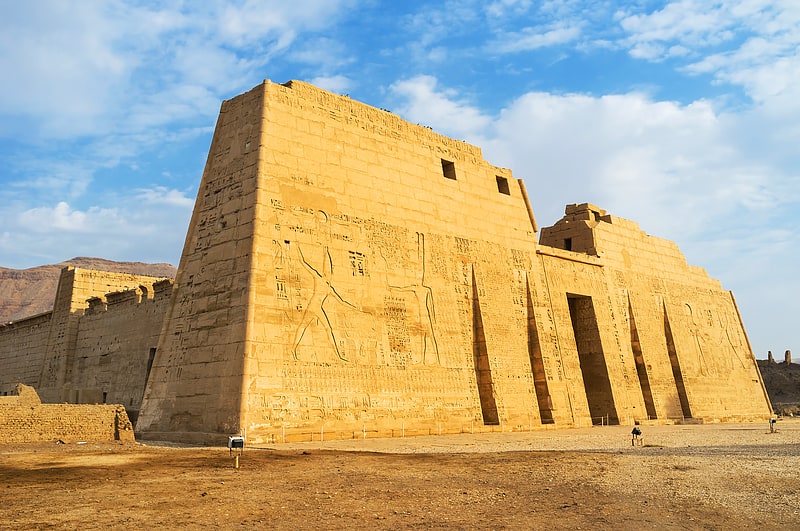
Also known as: معبد رمسيس الثالث
Ancient temple and tomb of Ramesses III. Medinet Habu is an archaeological locality situated near the foot of the Theban Hills on the West Bank of the River Nile opposite the modern city of Luxor, Egypt. Although other structures are located within the area, the location is today associated almost exclusively with the Mortuary Temple of Ramesses III.[3]
Address: Al Bairat, Luxor
Khan el-Khalili, Cairo

Also known as: خان الخليلي
Major bazaar selling souvenirs and crafts. Khan el-Khalili is a famous bazaar and souq in the historic center of Cairo, Egypt. Established as a center of trade in the Mamluk era and named for one of its several historic caravanserais, the bazaar district has since become one of Cairo's main attractions for tourists and Egyptians alike. It is also home to many Egyptian artisans and workshops involved in the production of traditional crafts and souvenirs. The name Khan el-Khalili historically referred to a single building in the area; today it refers to the entire shopping district.[4]
Address: Gohar Al Kaed, El-gamaleya, Qism El-gamaleya, Cairo, Cairo (القاهرة الإسلامية)
Luxor Temple, Luxor
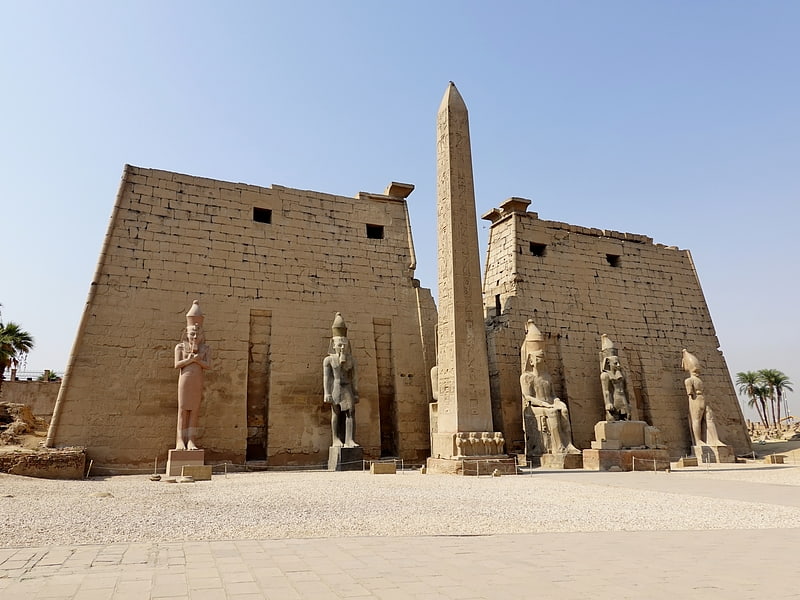
Also known as: معبد الأقصر
Egyptian temple in Luxor, Egypt. The Luxor Temple is a large Ancient Egyptian temple complex located on the east bank of the Nile River in the city today known as Luxor and was constructed approximately 1400 BCE. In the Egyptian language it was known as ipet resyt, "the southern sanctuary". It was one of the two primary temples on the east bank, the other being Karnak. Unlike the other temples in Thebes, Luxor temple is not dedicated to a cult god or a deified version of the pharaoh in death. Instead, Luxor temple is dedicated to the rejuvenation of kingship; it may have been where many of the pharaohs of Egypt were crowned in reality or conceptually.
To the rear of the temple are chapels built by Amenhotep III of the 18th Dynasty, and Alexander. Other parts of the temple were built by Tutankhamun and Ramesses II. During the Roman era, the temple and its surroundings were a legionary fortress and the home of the Roman government in the area. During the Roman period a chapel inside the Luxor Temple originally dedicated to the goddess Mut was transformed into a Tetrarchy cult chapel and later into a church.
Along with the other archeological sites in Thebes, the Luxor Temple was inscribed on the UNESCO World Heritage List in 1979.[5]
Address: Corniche El Nil St. Luxor, 23512 Luxor
Great Sphinx of Giza, Cairo
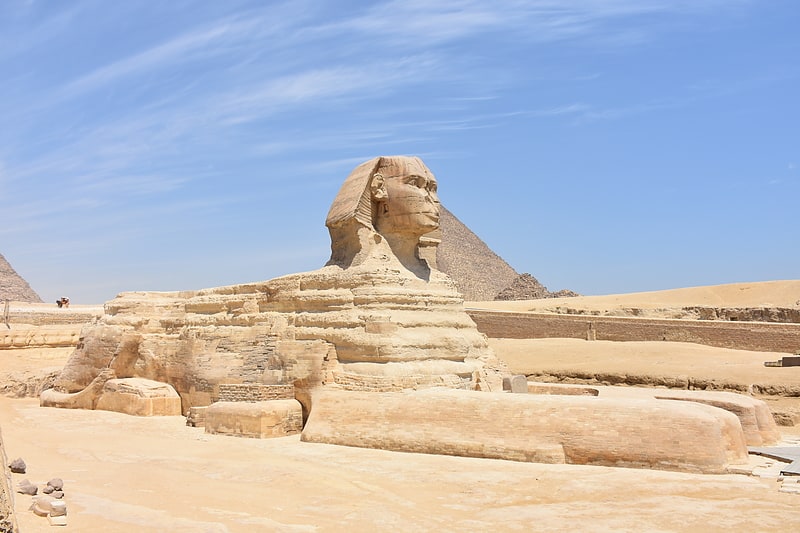
Also known as: أبو الهول
Monolithic Ancient Egyptian monument. The Great Sphinx of Giza, commonly referred to as the Sphinx of Giza, Great Sphinx or just the Sphinx, is a limestone statue of a reclining sphinx, a mythical creature with the head of a human, and the body of a lion. Facing directly from west to east, it stands on the Giza Plateau on the west bank of the Nile in Giza, Egypt. The face of the Sphinx appears to represent the pharaoh Khafre.
Cut from the bedrock, the original shape of the Sphinx has been restored with layers of limestone blocks. It measures 73 m (240 ft) long from paw to tail, 20 m (66 ft) high from the base to the top of the head and 19 m (62 ft) wide at its rear haunches. Its nose was broken off for unknown reasons between the 3rd and 10th centuries AD.
The Sphinx is the oldest known monumental sculpture in Egypt and one of the most recognisable statues in the world. The archaeological evidence suggests that it was created by ancient Egyptians of the Old Kingdom during the reign of Khafre (c. 2558–2532 BC).[6]
Address: Al Ahram, Cairo
Papas Beach Club, Hurghada

Beach, Bars and clubs, Nightlife, Beach bar, Night club, Sports bar
Address: Marina Boulevard, 23096 الغردقة
Unfinished obelisk, Aswan

Also known as: مسلة ناقصة
Massive obelisk in an ancient quarry. The unfinished obelisk is the largest known ancient obelisk and is located in the northern region of the stone quarries of ancient Egypt in Aswan, Egypt. It was studied in detail by Reginald Engelbach in 1922.[7]
Citadel of Qaitbay, Alexandria

Also known as: قلعة قايتباي
15th-century fortress and naval museum. The Citadel of Qaitbay is a 15th-century defensive fortress located on the Mediterranean sea coast, in Alexandria, Egypt. It was established in 1477 AD by Sultan Al-Ashraf Sayf al-Din Qa'it Bay. The Citadel is situated on the eastern side of the northern tip of Pharos Island at the mouth of the Eastern Harbour.[8]
Address: As Sayalah Sharq, Alexandria
Nubian Museum, Aswan
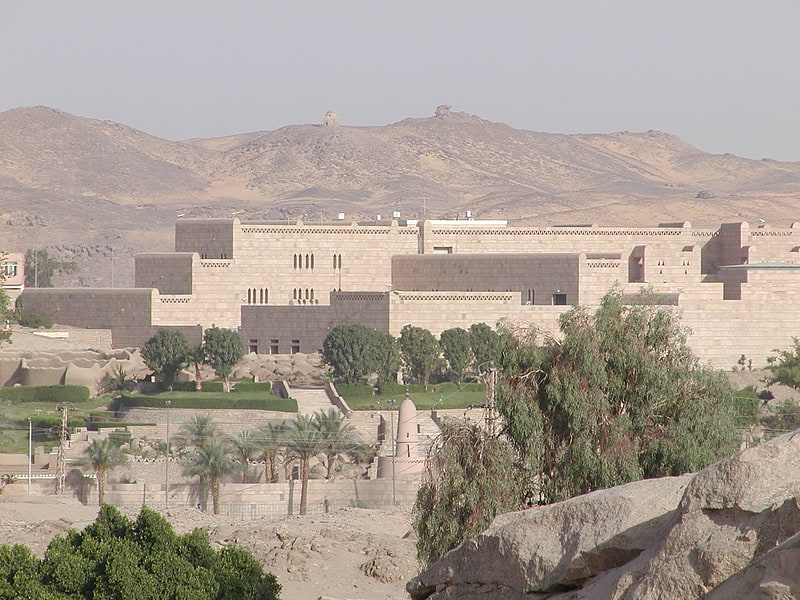
Also known as: متحف النوبة
Historical and cultural Egyptian artifacts. The Nubian Museum is an archaeological museum located in Aswan, Upper Egypt. It was built to a design by architect Mahmoud El-Hakim for an estimated construction cost of LE 75 million. Dedicated to Nubian culture and civilization, it was inaugurated on November 23, 1997, and was awarded the Aga Khan Award for Architecture in 2001.[9]
Address: El Fanadeq St. Downtown, 81111 Aswan
Montaza Palace, Alexandria

Also known as: قصر المنتزه
1932 ornate palace and extensive gardens. Montaza Palace is a palace, museum and extensive gardens in the Montaza district of Alexandria, Egypt. It was built on a low plateau east of central Alexandria overlooking a beach on the Mediterranean Sea.[10]
Address: Al Montaza, Alexandria
Sea Aquarium, Hurghada

Top attraction, Aquarium, Zoo
Address: Corniche Rd, Hurghada
Pompey's Pillar, Alexandria

Also known as: عمود السواري
Iconic Roman-era granite column. Pompey's Pillar is the name given to a Roman triumphal column in Alexandria, Egypt. Set up in honour of the Roman emperor Diocletian between 298–302 AD, the giant Corinthian column originally supported a colossal porphyry statue of the emperor in armour. It stands at the eastern side of the temenos of the Serapeum of Alexandria, beside the ruins of the temple of Serapis itself. The erroneous name and association with Pompey stems from historical misreading of the Greek dedicatory inscription on the base.[11]
Address: Amud Al Sawary, Alexandria
Mausoleum of Aga Khan, Aswan
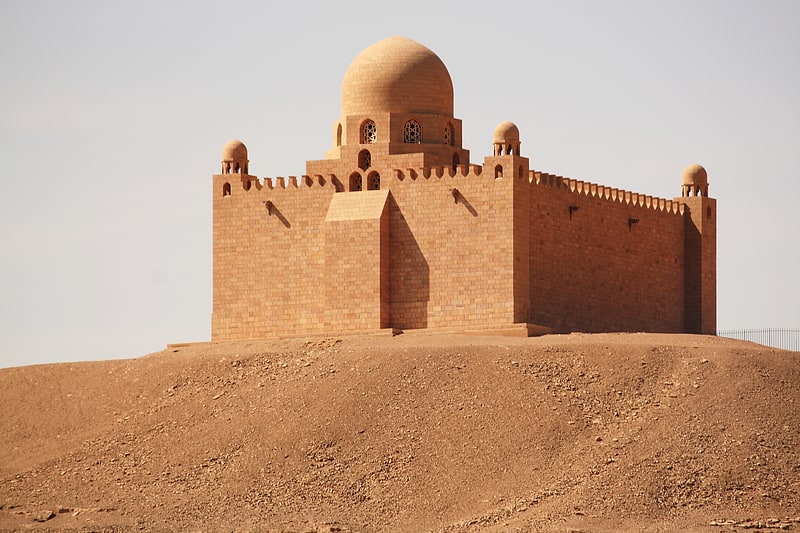
Also known as: ضريح أغا خان
Historical landmark in Egypt. The Mausoleum of Aga Khan is the mausoleum of Aga Khan III, Sir Sultan Muhammed Shah, who died in 1957. The mausoleum is located at Aswan along the Nile of Egypt, since Egypt was formerly the centre of power of the Fatimids, an Ismaili Shia dynasty.
The construction of the mausoleum began in 1956 and ended in 1960. The Aga Khan's wife, Begum Om Habibeh Aga Khan, commissioned the construction of the mausoleum, which initially accepted tourists inside; however, the interior was closed off to the public in 1997.
A red rose is laid on the Aga Khan's tomb every day--a practice first started by Begum Om Habibeh Aga Khan.[12]
Hurghada Grand Aquarium, Hurghada

Aquarium in Hurghada, Egypt. Hurghada Aquarium is an aquarium located in Hurghada, Red Sea Governorate, Egypt in Magawish area. It opened in January 2015, and contains nearly 3,500 cubic metres in tank space. It is home to over 1200 individual animals, and 100 species. It is easily one of the continent's largest aquariums, as well as Egypt's largest and nearly the largest in the Arab world. It contains 24 separate exhibits, included among them a shark tunnel, rainforest and "Whale Valley", based on fossils found in the Western Desert. The facility is also home to a Bedouin life exhibit, and an animal zoo. The Aquarium's notable specimens include: nurse shark, stingrays, green sea turtle, shovelnose guitarfish and eagle rays.[13]
Address: Villages Road, 84511 Hurghada
Pyramid of Djoser, Saqqara

Also known as: هرم زوسر
Ruins of step pyramid built for pharaoh. The Pyramid of Djoser, or Step Pyramid, is an archaeological site in the Saqqara necropolis, Egypt, northwest of the city of Memphis. The 6-tier, 4-sided structure is the earliest colossal stone building in Egypt. It was built in the 27th century BC during the Third Dynasty for the burial of Pharaoh Djoser. The pyramid is the central feature of a vast mortuary complex in an enormous courtyard surrounded by ceremonial structures and decoration. Its architect was Imhotep, chancellor of the pharaoh and high priest of the god Ra.
The pyramid went through several revisions and redevelopments of the original plan. The pyramid originally stood 62.5 m (205 ft) tall, with a base of 109 m × 121 m (358 ft × 397 ft) and was clad in polished white limestone. The step pyramid (or proto-pyramid) was considered to be the earliest large-scale cut stone construction made by man as of 1997, although the nearby enclosure wall "Gisr el-Mudir" is suggested by some Egyptologists to predate the complex, and the South American pyramids at Caral are contemporary.
In March 2020, the pyramid was reopened for visitors after a 14-year restoration.[14]
Pyramid of Unas, Saqqara
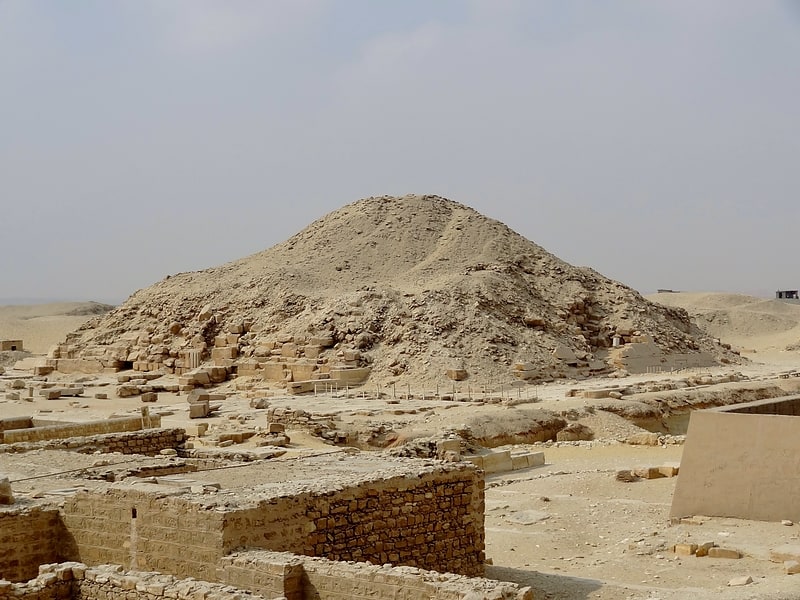
Also known as: هرم أوناس
The Pyramid of Unas is a smooth-sided pyramid built in the 24th century BC for the Egyptian pharaoh Unas, the ninth and final king of the Fifth Dynasty. It is the smallest Old Kingdom pyramid, but significant due to the discovery of Pyramid Texts, spells for the king's afterlife incised into the walls of its subterranean chambers. Inscribed for the first time in Unas's pyramid, the tradition of funerary texts carried on in the pyramids of subsequent rulers, through to the end of the Old Kingdom, and into the Middle Kingdom through the Coffin Texts that form the basis of the Book of the Dead.
Unas built his pyramid between the complexes of Sekhemket and Djoser, in North Saqqara. Anchored to the valley temple at a nearby lake, a long causeway was constructed to provide access to the pyramid site. The causeway had elaborately decorated walls covered with a roof which had a slit in one section allowing light to enter, illuminating the images. A long wadi was used as a pathway. The terrain was difficult to negotiate and contained old buildings and tomb superstructures. These were torn down and repurposed as underlay for the causeway. A significant stretch of Djoser's causeway was reused for embankments. Tombs that were on the path had their superstructures demolished and were paved over, preserving their decorations. Two Second Dynasty tombs, presumed to belong to Hotepsekhemwy, Nebra, and Ninetjer, from seals found inside, are among those that lie under the causeway. The site was later used for numerous burials of Fifth Dynasty officials, private individuals from the Eighteenth to Twentieth Dynasties, and a collection of Late Period monuments known as the "Persian tombs".
The causeway joined the temple in the harbour with the mortuary temple on the east face of the pyramid. The mortuary temple was entered on its east side through a large granite doorway, seemingly constructed by Unas's successor, Teti. Just south of the upper causeway are two long boat pits. These may have contained two wooden boats: the solar barques of Ra, the sun god. The temple was laid out in a similar manner to Djedkare Isesi's. A transverse corridor separates the outer from the inner temple. The entry chapel of the inner temple has been completely destroyed, though it once contained five statues in niches. A feature of the inner temple was a single quartzite column that was contained in the antichambre carrée. The room is otherwise ruined. Quartzite is an atypical material to use in architectural projects, though examples of it being used sparingly in the Old Kingdom exist. The material is associated with the sun cult due to its sun-like coloration.
The underground chambers remained unexplored until 1881, when Gaston Maspero, who had recently discovered inscribed texts in the pyramids of Pepi I and Merenre I, gained entry. Maspero found the same texts inscribed on the walls of Unas's pyramid, their first known appearance. The 283 spells in Unas's pyramid constitute the oldest, smallest and best preserved corpus of religious writing from the Old Kingdom. Their function was to guide the ruler through to eternal life and ensure his continued survival even if the funerary cult ceased to function. In Unas's case, the funerary cult may have survived the turbulent First Intermediate Period and up until the Twelfth or Thirteenth Dynasty, during the Middle Kingdom. This is a matter of dispute amongst Egyptologists, where a competing idea is that the cult was revived during the Middle Kingdom, rather than having survived until then.[15]
Address: South of the Step Pyramid, 11511 Cairo
Pyramid of Nyuserre, Saqqara

Ruin in Egypt. The Pyramid of Nyuserre is a mid-25th-century BC pyramid complex built for the Egyptian pharaoh Nyuserre Ini of the Fifth Dynasty. During his reign, Nyuserre had the unfinished monuments of his father, Neferirkare Kakai, mother, Khentkaus II, and brother, Neferefre, completed, before commencing work on his personal pyramid complex. He chose a site in the Abusir necropolis between the complexes of Neferirkare and Sahure, which, restrictive in area and terrain, economized the costs of labour and material. Nyuserre was the last king to be entombed in the necropolis; his successors chose to be buried elsewhere. His monument encompasses a main pyramid, a mortuary temple, a valley temple on Abusir Lake, a causeway originally intended for Neferirkare's monument, and a cult pyramid.
The main pyramid had a stepped core built from rough-cut limestone and encased in fine Tura limestone. The casing was stripped down by stone thieves, leaving the core exposed to the elements and further human activity, which have reduced the once nearly 52 m (171 ft; 99 cu) tall pyramid to a mound of ruins, with a substructure that is dangerous to enter due to the risk of cave-ins. Adjoining the pyramid's east face is the mortuary temple with its unusual configuration and features. Replacing the usual T-shape plan, the mortuary temple has an L-shape; an alteration required due to the presence of mastabas to the east. It debuted the antichambre carrée, a square room with a single column, which became a standard feature of later monuments. It also contains an unexplained square platform which has led archaeologists to suggest that there may be a nearby obelisk pyramidion. This is unusual as obelisks were central features of Egyptian sun temples, but not of pyramid complexes. Finally, the north-east and south-east corners of the site have two structures which appear to have been pylon prototypes. These became staple features of temples and palaces. In the south-east corner of the complex, a separate enclosure hosts the cult pyramid – a small pyramid whose purpose remains unclear. A long causeway binds the mortuary and valley temples. These two were under construction for Neferirkare's monument, but were repurposed for that of Nyuserre. The causeway, which had been more than half completed when Neferirkare died, thus has a bend where it changes direction from Neferirkare's mortuary temple towards Nyuserre's.
Two other pyramid complexes have been found in the area. Known as Lepsius XXIV and Lepsius XXV, they may have belonged to the consorts of Nyuserre, particularly Queen Reputnub, or of Neferefre. Further north-west of the complex are mastabas built for the pharaoh's children. The tombs of the priests and officials associated with the king's funerary cult are located in the vicinity as well. Whereas the funerary cults of other kings died out in the First Intermediate Period, Nyuserre's may have survived this transitional period and into the Middle Kingdom, although this remains a contentious issue among Egyptologists.[16]
Port Said Lighthouse, Port Said
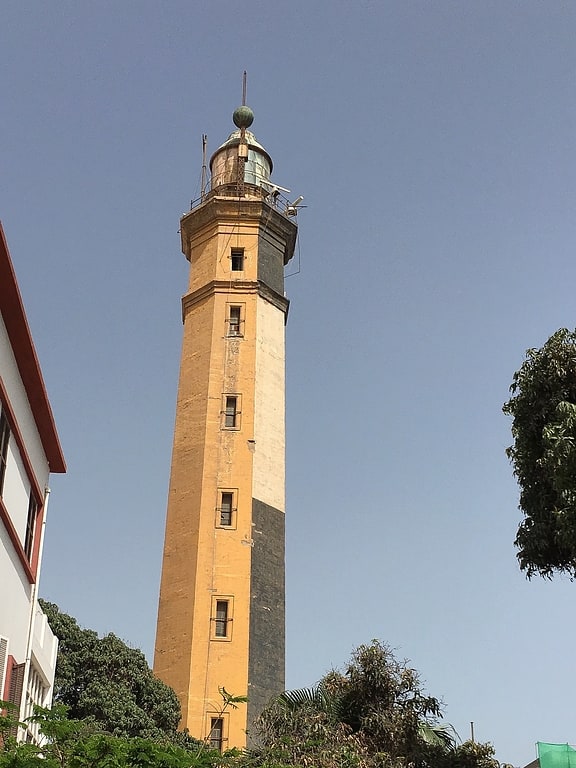
Also known as: فنار بورسعيد القديم
Lighthouse in Port Said, Egypt. The Port Said Lighthouse is one of the most important architectural and tourist landmarks in the city of Port Said in Egypt. Considered a unique example for the evolution of architecture during the nineteenth century in the city, the lighthouse was designed by François Coignet at the request of the Khedive of Egypt and Sudan, Ismail the Magnificent. Construction was completed in 1869, one week prior to the inauguration of the Suez Canal. The lighthouse was built to guide ships passing through the canal. The lighthouse has an octagonal shaped tower that is 56 m high.[17]
Address: Palestine street, Port Said
Museum of Modern Art in Egypt, Port Said
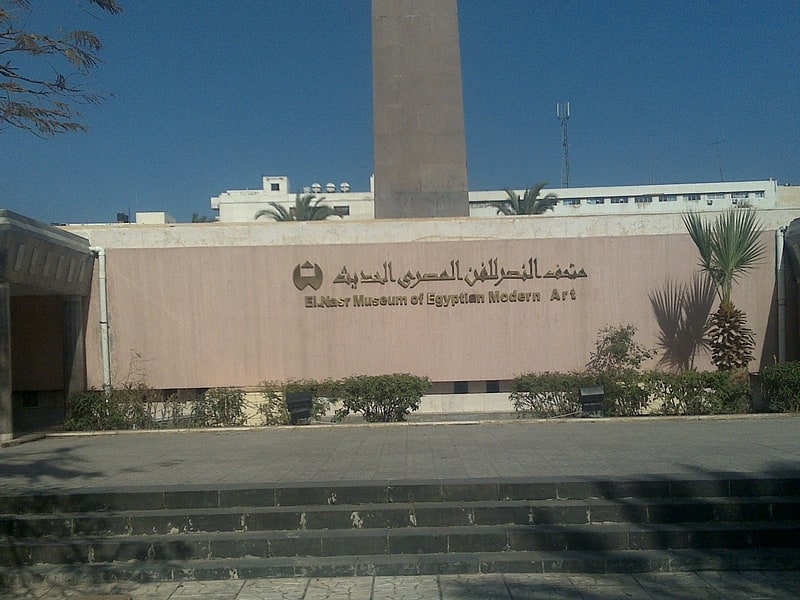
Also known as: متحف النصر للفن الحديث
Museum in Port Said, Egypt. Museum of Modern Art—Port Said is a modern and contemporary art museum, located in Shohada Square, in Port Said, Egypt.
The town of Port Said has an international history of being a cultural crossroads and cosmopolitan community, located at the confluence of the Suez Canal and Mediterranean Sea, on the easternmost edge of the Nile Delta region.[18]
Address: 23rd of July street, Port Said